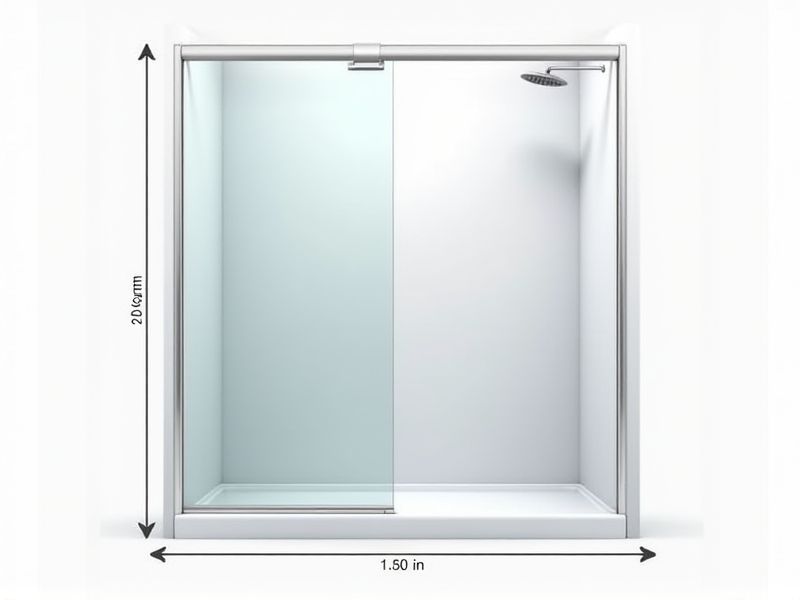
When planning a shower enclosure, the most common standard dimensions are 36 inches by 36 inches, which provides comfortable space for most users. For smaller bathrooms, enclosures may be as compact as 32 inches by 32 inches, while larger walk-in models often start at 36 inches by 48 inches or bigger. It's important to consider both the available bathroom space and accessibility requirements when selecting a size. Always ensure there's adequate clearance around the enclosure for easy entry and exit, and refer to local building codes for minimum requirements.
Height: Typically 72 To 78 Inches
The height of a standard shower enclosure typically ranges from 72 to 78 inches, accommodating various user preferences and ensuring adequate splash protection. This height is designed to provide ample space for most individuals while maintaining a comfortable and functional showering experience. By adhering to these measurements, you can enhance water containment and minimize the chances of spills outside the enclosure. Selecting the right height also contributes to the overall aesthetic appeal of your bathroom, blending seamlessly with your design vision.
Width: Commonly 36 To 60 Inches
A shower enclosure typically has a width ranging from 36 to 60 inches, providing ample space for comfortable use. Enclosures within this width range cater to various bathroom sizes and design preferences, making them versatile for modern renovations. For optimal functionality, a width of at least 48 inches is often recommended, allowing for easier movement and accessibility. When considering your shower enclosure, ensure it fits well within your bathroom dimensions while also complementing the overall aesthetic.
Depth: Ranges From 30 To 36 Inches
The depth of a shower enclosure typically ranges from 30 to 36 inches, offering various options to suit different bathroom layouts. A depth of 30 inches is ideal for compact spaces, ensuring efficient use without sacrificing functionality. Opting for a deeper enclosure at 36 inches provides a more spacious experience, accommodating users who prefer extra room. When selecting the perfect depth, consider your comfort and the overall dimensions of your bathroom to enhance usability and aesthetics.
Door Width: 22 To 36 Inches
The standard door width for shower enclosures ranges from 22 to 36 inches, accommodating various bathroom layouts and user needs. A width of 22 inches offers a compact solution for smaller spaces, while a 36-inch wide door provides easier access for individuals with mobility concerns. Ensuring your shower door meets these width specifications can enhance both functionality and safety within your bathroom. Choosing the appropriate size not only improves the shower entry experience but also contributes to the overall aesthetic appeal of your bathroom design.
Walk-In Space: Minimum 30 Inches For Comfort
A standard walk-in shower enclosure should offer a minimum space of 30 inches for optimal comfort and functionality. This dimension allows for easy movement and ensures that users can access all areas of the shower without feeling cramped. A larger walk-in area, ideally between 36 and 48 inches, enhances the experience, accommodating dual showerheads or a bench for convenience. Properly designed walk-in enclosures not only boost your bathroom's aesthetic appeal but also add significant value to your home, making them a worthwhile investment.
Glass Thickness: 3/8 To 1/2 Inch
When selecting a shower enclosure, glass thickness is a critical factor that impacts durability and safety. Popular options range from 3/8 inch to 1/2 inch, with 1/2 inch tempered glass offering enhanced sturdiness and resistance to breakage. For optimal performance, ensure the enclosure is framed or semi-framed to support the weight of thicker glass effectively. Choosing the right glass thickness can significantly enhance your bathroom's aesthetic and functionality while providing peace of mind.
Frameless Vs. Framed: Design Impacts Dimensions
Frameless shower enclosures offer a sleek, modern look, enhancing the perception of space in bathrooms, while framed options provide a more traditional aesthetic. In terms of dimensions, frameless designs often allow for larger glass panels, typically up to 3/8 inch thick, which can make a small bathroom feel more open. Framed enclosures, on the other hand, usually feature aluminum frames that can limit the overall glass size, with typical panel dimensions between 1/4 to 1/2 inch thick. Your choice between these two styles affects not only the visual appeal but also the functionality and maintenance of the shower space.
Corner Unit: Smaller Footprint, Often 32X32 Inches
A corner shower enclosure typically measures 32x32 inches, making it an ideal choice for maximizing space in compact bathrooms. This design not only ensures a smaller footprint but also allows for accessible entry points, often featuring sliding or bi-fold doors. Constructed from durable materials like tempered glass and aluminum frames, these units offer both safety and stylish aesthetics. Corner units often incorporate shelving or storage options, enhancing functionality without sacrificing valuable floor area.
Alcove Style: Fits Between Three Walls, Various Sizes
The alcove style shower enclosure is designed to fit snugly between three walls, optimizing your bathroom's space while enhancing its aesthetic appeal. Typically available in various sizes, these enclosures can range from 30 inches to 60 inches in width, catering to both compact and spacious bathrooms. You can choose from a variety of materials, including tempered glass and acrylic, ensuring durability and easy maintenance. This versatile shower solution often includes options for sliding doors or bi-fold designs, providing convenient access without sacrificing style.
Walk-In Design: Requires More Open Space For Entry
A walk-in shower enclosure typically demands a minimum space of 36 inches in width to ensure easy access and movement. This design often enhances accessibility, allowing users to enter without barriers, making it suitable for individuals with limited mobility. The absence of a door can create a more seamless look, integrating the shower area with the rest of your bathroom. Incorporating non-slip surfaces and built-in seating options further elevates the safety and comfort of your walk-in shower space.
